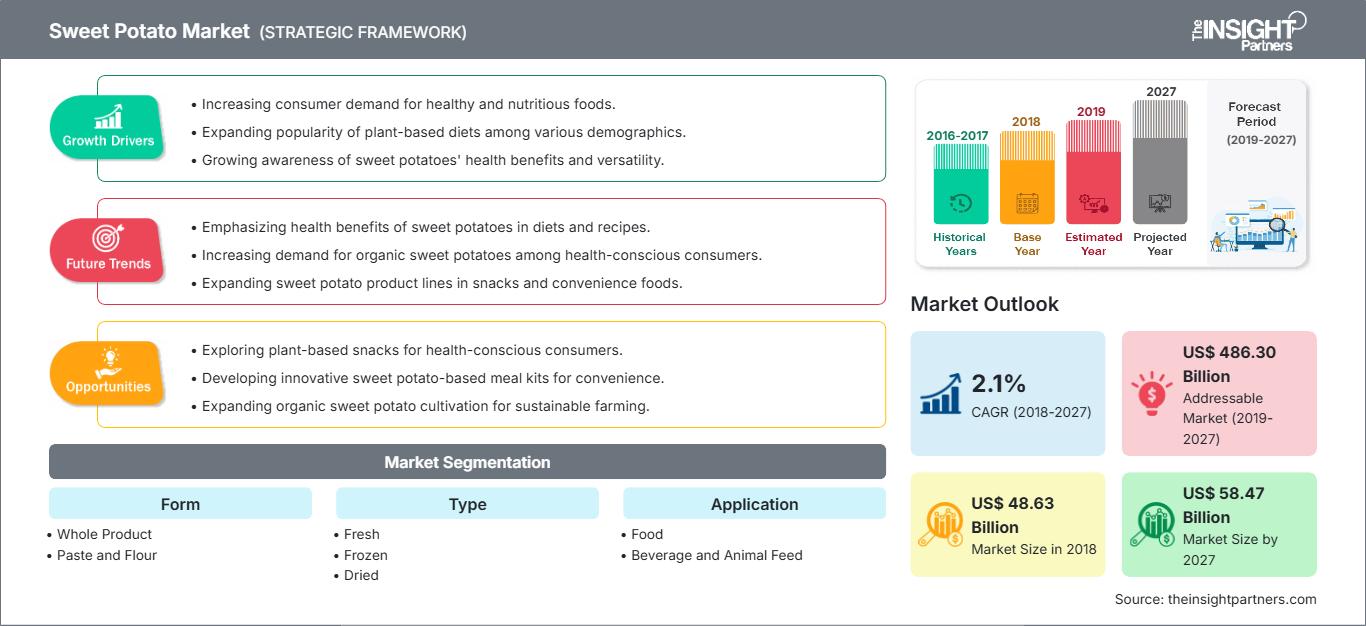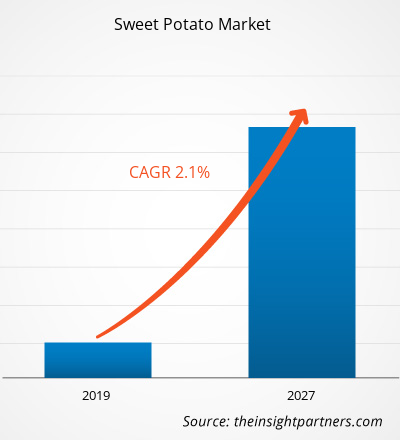Il mercato globale delle patate dolci ha rappresentato 48.628,8 milioni di dollari nel 2018 e si prevede che crescerà a un CAGR del 2,1% nel periodo di previsione 2019-2027, raggiungendo i 58.470,0 milioni di dollari entro il 2027.
La regione Asia-Pacifico detiene la quota di mercato maggiore nel mercato globale delle patate dolci. Il tasso di produzione e consumo di patate dolci è in rapida espansione, con la Cina e il resto dell'Asia-Pacifico che rappresentano i principali mercati per l'industria delle patate dolci. L'Asia-Pacifico si è evoluta come il maggiore consumatore ed esportatore di patate dolci. La produzione di patate dolci ha contribuito in modo significativo alle economie nazionali della regione Asia-Pacifico negli ultimi anni. Il mercato dell'Asia-Pacifico è caratterizzato dalla presenza di attori come Dole Food Company INC. e HJ Heinz Company Brands LLC. , Lamb Weston Holdings, INC., Nash Produce, The JR Simplot Company, tra gli altri.
Opportunità di Market Insights per gli agricoltori in Medio Oriente e Africa a causa della carenza di patate dolci in Nord America ed Europa
Il consumo di patate dolci è in aumento poiché offre diversi vantaggi per la salute. Le aziende alimentari e delle bevande situate in Nord America ed Europa hanno sviluppato prodotti innovativi a base di patate dolci che offrono un'ottima combinazione di gusto e valore nutrizionale. I produttori di alimenti e bevande cercano costantemente di introdurre prodotti più innovativi con ingredienti familiari per guadagnare terreno tra i consumatori attenti alla salute. La principale preoccupazione per il Nord America e l'Europa è la carenza nella produzione di patate dolci. Il basso prezzo è una delle ragioni principali della scarsa produzione di patate dolci in Nord America. Le incertezze climatiche sono un altro motivo che ha contribuito alla scarsa produzione di patate dolci in Nord America ed Egitto. I recenti uragani e le forti piogge del 2018 negli Stati Uniti sono stati un fattore significativo che ha distrutto il totale delle patate dolci coltivate in quella stagione. La domanda di patate dolci in Nord America è in crescita e questo ha creato una grande opportunità per gli agricoltori del Medio Oriente e dell'Africa di esportare il loro raccolto in questa regione.
Personalizza questo rapporto in base alle tue esigenze
Potrai personalizzare gratuitamente qualsiasi rapporto, comprese parti di questo rapporto, o analisi a livello di paese, pacchetto dati Excel, oltre a usufruire di grandi offerte e sconti per start-up e università
Mercato delle patate dolci: Approfondimenti strategici

-
Ottieni le principali tendenze chiave del mercato di questo rapporto.Questo campione GRATUITO includerà l'analisi dei dati, che vanno dalle tendenze di mercato alle stime e alle previsioni.
I produttori del settore alimentare e delle bevande si stanno concentrando sulle principali tendenze di mercato e sulle esigenze dei consumatori per sviluppare prodotti innovativi e aumentare le vendite dell'intera linea di prodotti. Pertanto, negli ultimi anni, diverse aziende hanno lanciato prodotti innovativi a base di patate dolci che offrono opzioni salutari ai consumatori. Nel 2018, Starbucks Japan ha lanciato un'edizione limitata di frappuccino e latte croccante a base di patate dolci, mentre Campbell Soup Company ha lanciato una nuova bevanda vegana a base di succo di patate dolci per soddisfare la crescente domanda di prodotti a base vegetale. Nel 2018 sono stati lanciati diversi altri prodotti a base di patate dolci, come waffle, patatine, bignè, bastoncini, pagnotte e barrette. Pertanto, si prevede che la crescente propensione verso i prodotti a base vegetale e il crescente utilizzo delle patate dolci in vari prodotti stimoleranno il mercato delle patate dolci nel periodo di previsione.
Approfondimenti sulla forma
In base alla forma, il mercato globale delle patate dolci è stato segmentato in prodotto intero, pasta e farina. Nel segmento delle forme, l'intero mercato dei prodotti ha guidato il mercato globale delle patate dolci. Inoltre, si prevede che il segmento della farina registrerà il CAGR più rapido nel periodo previsto. Nel suo complesso, la patata dolce viene coltivata da oltre 8000 anni. Le patate dolci sono una ricca fonte di amido, fibre e nutrienti come la vitamina A. Il basso contenuto di fruttosio della patata dolce ha trovato applicazione nell'industria delle bevande ed è anche utilizzata come alternativa allo zucchero di canna in vari succhi concentrati. La patata dolce è disponibile in diversi colori, come marrone, arancione e viola. Il colore distintivo della patata dolce la rende un'opzione adatta per l'utilizzo in varie formulazioni lattiero-casearie come formaggio e burro. Questo contribuisce ulteriormente a rafforzare il mercato globale delle patate dolci.
Approfondimenti regionali sul mercato delle patate dolci
Le tendenze regionali e i fattori che influenzano il mercato delle patate dolci durante il periodo di previsione sono stati ampiamente spiegati dagli analisti di The Insight Partners. Questa sezione analizza anche i segmenti e la geografia del mercato delle patate dolci in Nord America, Europa, Asia-Pacifico, Medio Oriente e Africa, America meridionale e centrale.
Ambito del rapporto sul mercato delle patate dolci
| Attributo del rapporto | Dettagli |
|---|---|
| Dimensioni del mercato in 2018 | US$ 48.63 Billion |
| Dimensioni del mercato per 2027 | US$ 58.47 Billion |
| CAGR globale (2018 - 2027) | 2.1% |
| Dati storici | 2016-2017 |
| Periodo di previsione | 2019-2027 |
| Segmenti coperti |
By Forma
|
| Regioni e paesi coperti |
Nord America
|
| Leader di mercato e profili aziendali chiave |
|
Densità degli operatori del mercato delle patate dolci: comprendere il suo impatto sulle dinamiche aziendali
Il mercato delle patate dolci è in rapida crescita, trainato dalla crescente domanda da parte degli utenti finali, dovuta a fattori quali l'evoluzione delle preferenze dei consumatori, i progressi tecnologici e una maggiore consapevolezza dei benefici del prodotto. Con l'aumento della domanda, le aziende stanno ampliando la propria offerta, innovando per soddisfare le esigenze dei consumatori e sfruttando le tendenze emergenti, alimentando ulteriormente la crescita del mercato.

- Ottieni il Mercato delle patate dolci Panoramica dei principali attori chiave
Il mercato globale delle patate dolci è stato segmentato in base alla tipologia in fresche, congelate, essiccate e altre. Il segmento delle patate dolci fresche rappresenta la quota maggiore del mercato globale delle patate dolci. Le patate dolci fresche sono quelle raccolte direttamente dalle aziende agricole. Le patate dolci fresche non sono adulterate con alcun tipo di conservante o fertilizzante. Sono altamente ricche di fibre, amido e vitamina A. Le patate dolci biologiche non sono considerate fresche in quanto adulterate con vari conservanti e fertilizzanti. Si prevede che questi fattori favoriranno la crescita del mercato delle patate dolci nel periodo di previsione.
Fusioni e acquisizioni sono state osservate come le strategie più adottate nel mercato globale delle patate dolci. Di seguito sono elencati alcuni degli sviluppi recenti nel mercato globale delle patate dolci:
2019: Jackson Farming Company ha acquisito e mantenuto il team di vendita di Wayne Bailey Produce, che dovrebbe aiutare l'azienda ad espandere la sua presenza nel settore delle patate dolci.2019: Lamb Weston Holdings, Inc. ha stipulato un accordo per l'acquisizione di Ready Meals Pty Ltd. Quest'ultima vendeva prodotti a base di patate surgelate con il marchio Harvest Choice.2018: Ham Farms ha deciso di lanciare il suo marchio di prodotti biologici di prima qualità, disponibile sfuso e in sacchi da 3 libbre, 5 libbre e 10 libbre.
Mercato globale delle patate dolci - Per forma
- Prodotto intero
- Pasta
- Farina
Mercato globale delle patate dolci - Per tipo
- Fresco
- Surgelato
- Essiccato
Mercato globale delle patate dolci - Per applicazione
- Alimenti
- Bevande
- Mangimi per animali
Mercato globale delle patate dolci - Per area geografica
-
America del Nord
- Stati Uniti
- Messico
- Resto del Nord America
-
Europa
- Grecia
- Portogallo
- Italia
- Resto d'Europa
-
Asia Pacifico (APAC)
- Indonesia
- Cina
- India
- Giappone
- Taiwan
- Resto dell'Asia Pacifico
-
Medio Oriente e Africa (MEA)
- Africa
- Egitto
- Kenya
- Resto del MEA
-
Sud America
- Brasile
- Argentina
- Resto del Sud America (SAM)
Profili aziendali
- AV Thomas Produce
- Dole Food Company Inc.
- Ham Farms
- Jackson Farming Company
- Lamb Weston Holdings, Inc.
- McCain Foods Limited
- Nash Produce
- Simplot Food Group
- The Kraft Heinz Company
- Yantai China Pet Foods Co., Ltd
- Analisi storica (2 anni), anno base, previsione (7 anni) con CAGR
- Analisi PEST e SWOT
- Valore/volume delle dimensioni del mercato - Globale, Regionale, Nazionale
- Industria e panorama competitivo
- Set di dati Excel
Report recenti
Testimonianze
Motivo dell'acquisto
- Processo decisionale informato
- Comprensione delle dinamiche di mercato
- Analisi competitiva
- Analisi dei clienti
- Previsioni di mercato
- Mitigazione del rischio
- Pianificazione strategica
- Giustificazione degli investimenti
- Identificazione dei mercati emergenti
- Miglioramento delle strategie di marketing
- Aumento dell'efficienza operativa
- Allineamento alle tendenze normative






















 Ottieni un campione gratuito per - Mercato delle patate dolci
Ottieni un campione gratuito per - Mercato delle patate dolci